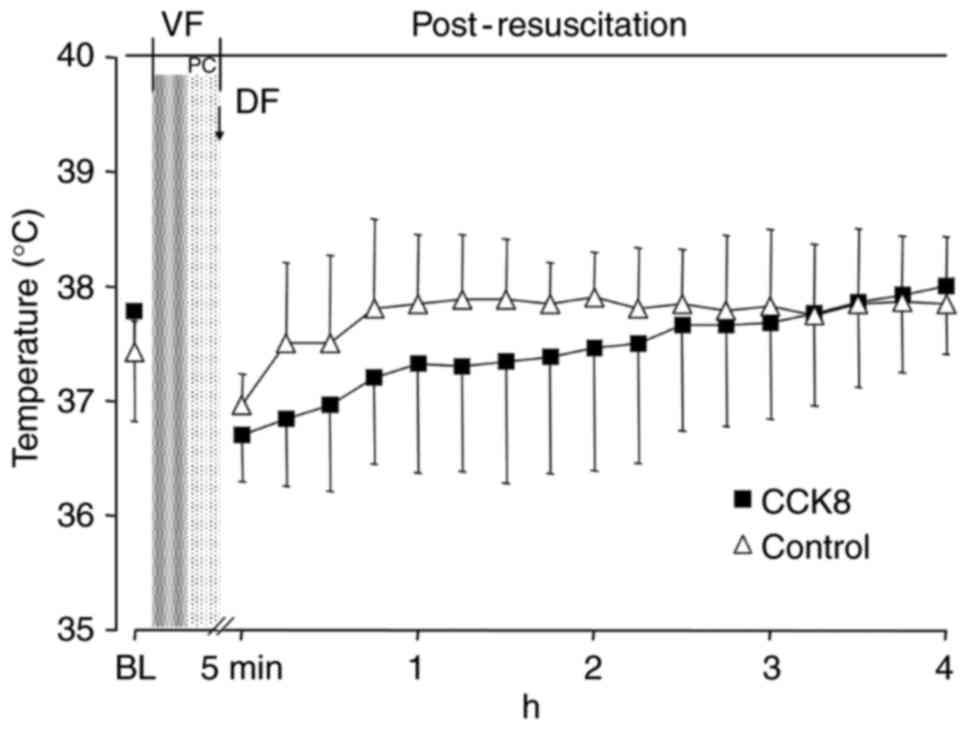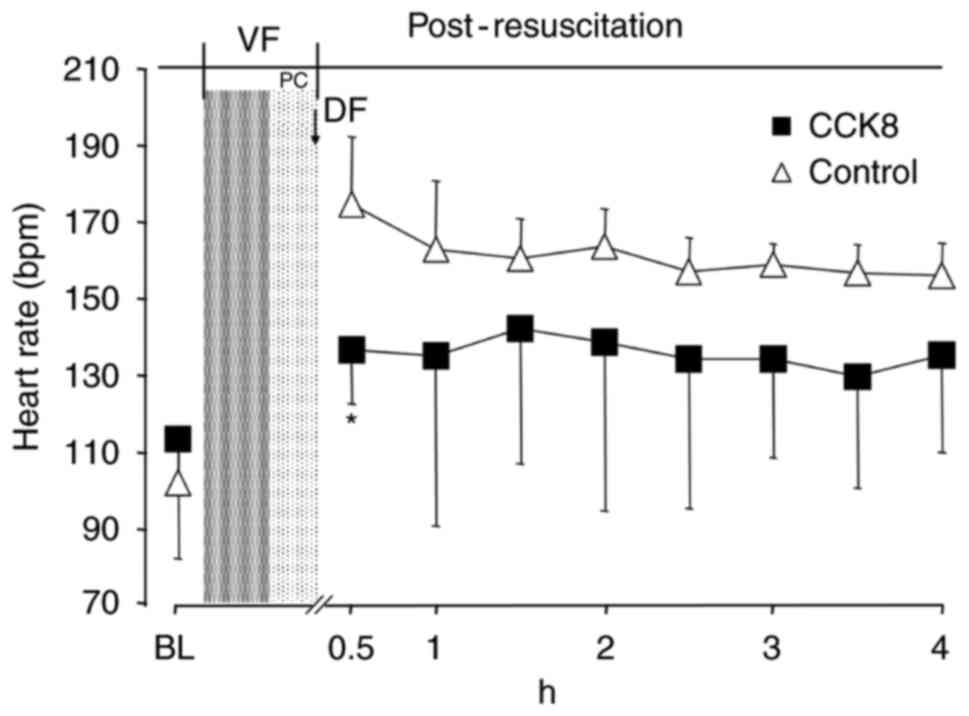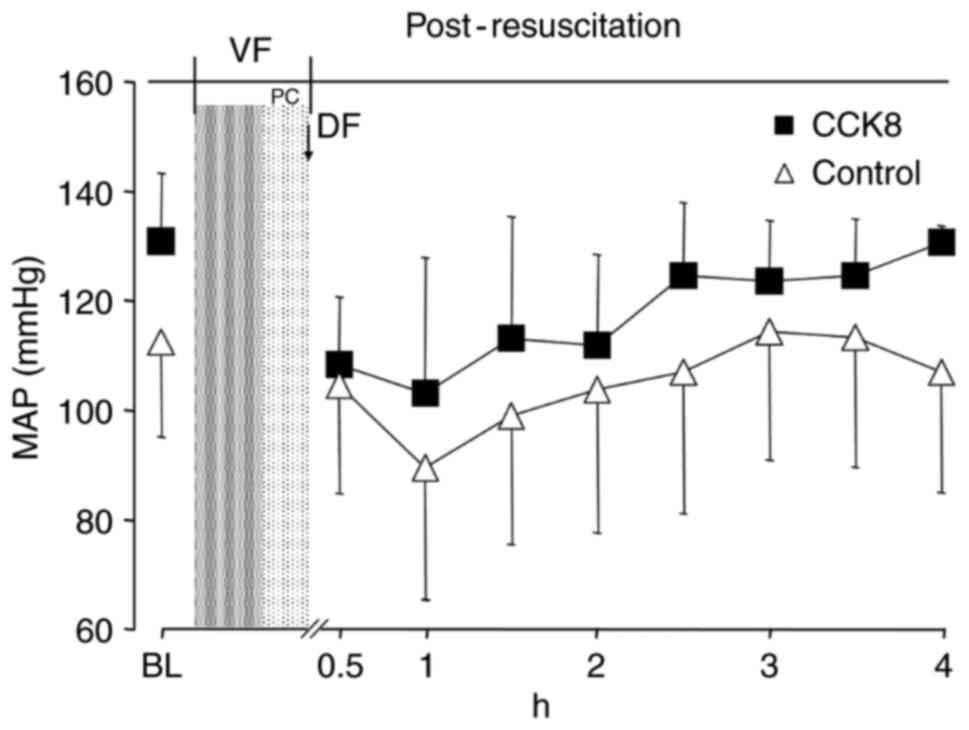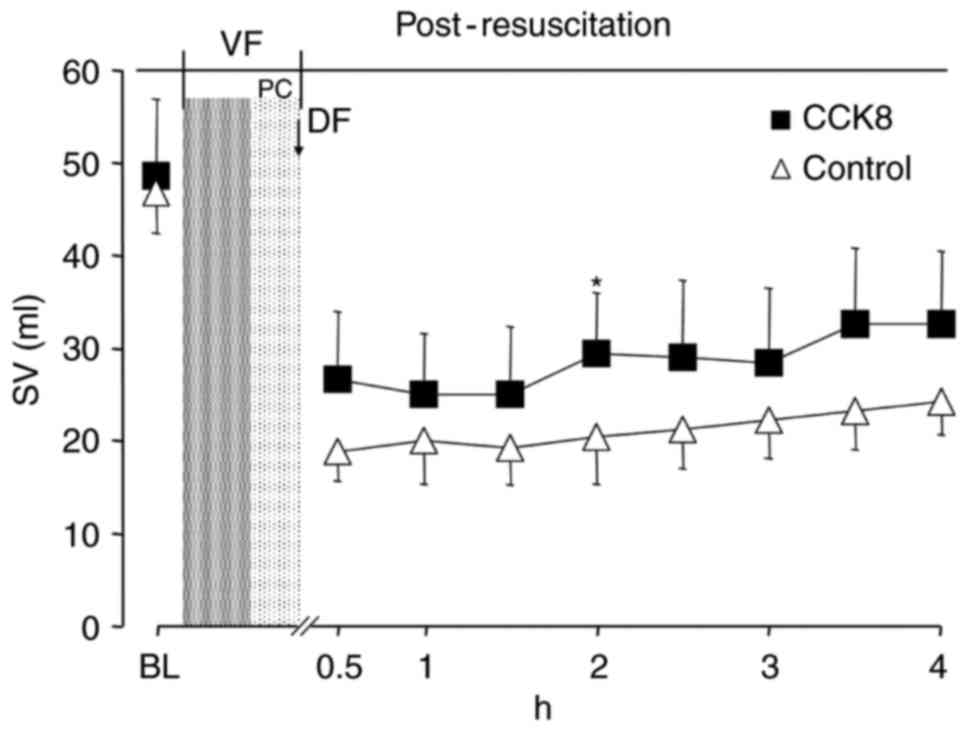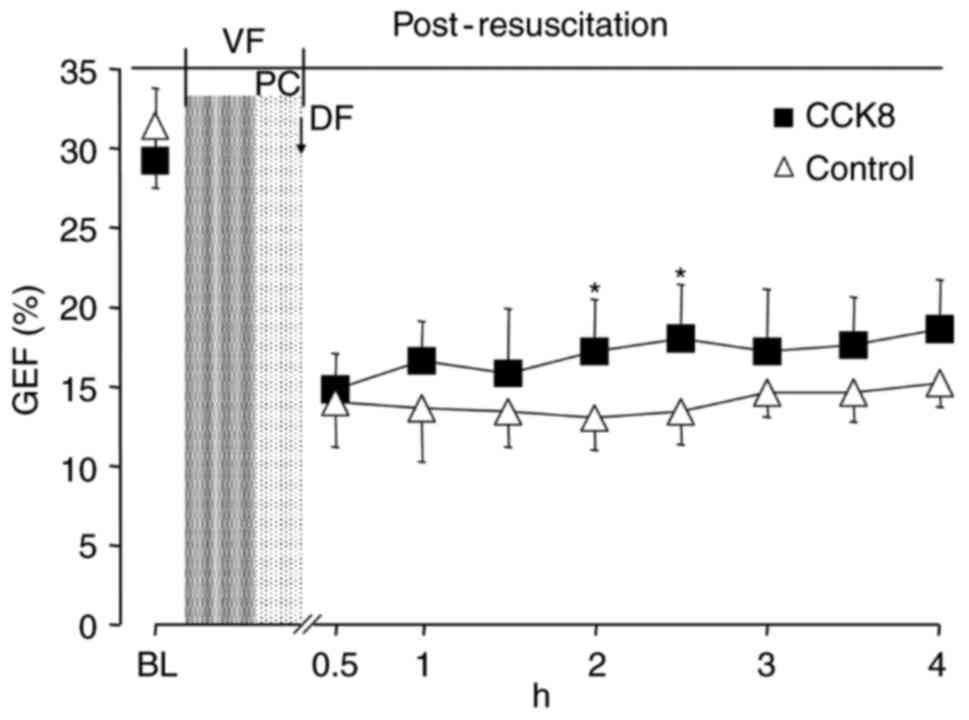Cholecystokinin octapeptide inhibits the inflammatory response and improves neurological outcome in a porcine model of cardiopulmonary resuscitation
- Authors:
- Published online on: December 27, 2017 https://doi.org/10.3892/etm.2017.5680
- Pages: 2583-2588
Abstract
Introduction
Cardiac arrest is the world's leading cause of fatality in heart disease (1). Out-of-hospital cardiac arrests lead to 295,000 mortalities in the USA, accompanied with 350,000 in Europe and 544,000 in China every year (1–3). Despite efforts to improve the treatment of cardiac arrest in recent years, survival to hospital discharge is only 10.6% (1). Two-thirds of patients with out-of-hospital cardiac arrest suffer mortality due to neurological injury, which is sustained during the anoxic, no-flow period of cardiac arrest or as a result of reperfusion injury, even following a successful resuscitation (4).
During the last decade, laboratory and clinical studies have demonstrated that targeted temperature management (32–36°C) following cardiopulmonary resuscitation (CPR) significantly improves neurological outcome (5,6). There are a variety of cooling methods available for post-resuscitation management, including pharmacologically-induced hypothermia, which reduces the body temperature by regulating the temperature center in the hypothalamus (7–9).
Cholecystokinin octapeptide (CCK8) is a type of central and peripheral neurotransmitter, which induces dose-dependent hypothermia when injected peripherally into rats and mice (10,11). It was also reported to induce mild hypothermia and improve myocardial and cerebral function in a rat model of CPR (9). In addition, CCK8 is effective in counteracting progressive neuronal dysfunction and damage, and inhibiting the systemic inflammatory response following sepsis (12–14).
In the present study, previous experiments performed in rodents were adapted for a large animal, porcine model of CPR, which is considered more clinically relevant. The effect of CCK8 on thermoregulation, myocardial function and neurological function was examined in a porcine model of CPR. It was hypothesized that CCK8 would induce hypothermia and improve neurological outcomes after resuscitation.
Materials and methods
Ethics statement
The present study was approved by the Animal Care and Use Committee of the First Affiliated Hospital of Nanjing Medical University (Nanjing, China). All animals received humane care according to the National Research Council's 1996 Guide for the Care and Use of Laboratory Animals (15).
Animal preparation
Bama miniature pigs were selected for use in the present study and they were purchased from Shanghai Jiagan Biological Technology Inc., (Shanghai, China). A total of 12 male Bama miniature pigs at the age of 6 months, weighing 20–25 kg, underwent overnight fasting except for free access to water. The animal room was maintained at 19–24°C, with relative humidity between 40 and 60% and a 12-h light/dark cycle. All animals were anesthetized by an intramuscular injection of ketamine (20 mg/kg; cat. no. K2753) and an ear vein injection of sodium pentobarbital (30 mg/kg; cat. no. 1507002) (both Sigma-Aldrich; Merck KGaA, Darmstadt, Germany). Additional doses of sodium pentobarbital (8 mg/kg) were administered hourly to maintain anesthesia. The trachea was orally intubated and the animals were mechanically ventilated [tidal volume, 15 ml/kg; peak flow, 40 l/min; fraction of inspired oxygen (FiO2), 0.21) with a volume-controlled SynoVent E3 ventilator (Shenzhen Mindray Bio-Medical Electronics Co., Ltd., Shenzhen, China). End-tidal PCO2 (ETCO2) was monitored with a handheld ETCO2/SPO2 monitor (PMSH-300; SunLife Science, Inc., Shanghai, China). Respiratory frequency was adjusted to keep ETCO2 between 35 and 40 mmHg. A conventional lead II electrocardiogram (ECG) was monitored continuously.
A fluid-filled 5F transducer-tipped catheter (SPC-450S; Millar, Inc., Houston, TX, USA) was advanced through the right femoral artery and into the thoracic aorta to monitor the aortic pressure and collect blood samples. Another 7F pentalumen thermodilution-tipped catheter (Abbott Pharmaceutical Co., Ltd., Lake Bluff, IL, USA) was advanced through the right femoral vein and into the right atrium to measure the right atrial pressure and core temperature. For the measurement of myocardial function, including stroke volume (SV) and global ejection fraction (GEF), a PiCCOplus monitor (Pulsion Medical Systems SE, Feldkirchen, Germany) based on transpulmonary thermodilution was used. A 7F central venous catheter was inserted into the right internal jugular vein for the injection of iced saline. Another 4F thermistor-tipped arterial catheter was inserted into the left femoral artery. The arterial and central venous catheters were connected to the PiCCO system for discontinuous monitoring of SV and GEF. A 5F pacing catheter (EP Technologies, Inc., Sunnyvale, CA, USA) was then advanced through the right external jugular vein and into the right ventricle to induce ventricular fibrillation (VF), as confirmed by characteristic pressure morphology and fluoroscopy. The body temperature was maintained at 37.5±0.5°C with a cooling/warming blanket (Shanghai Full-Ying Biomedical Technology Co., Shanghai, China) prior to cardiac arrest.
Experimental procedures
The established porcine model of CPR was utilized as previously described (16,17). A total of 15 min prior to inducing VF, baseline data were recorded. VF was electrically induced with a 1-mA alternating current through a 5F pacing catheter delivered to the right ventricle. Mechanical ventilation was stopped following the onset of VF. After 10 min of untreated VF, precordial compression was initiated with a mechanical chest compressor (Weil MCC; SunLife Science, Inc.) and mechanical ventilation was performed again (tidal volume, 15 ml/kg; peak flow, 40 l/min; FiO2, 21%). Mechanical compression was programmed to maintain at a rate of 100 compressions/min and synchronized to keep a compression/ventilation ratio of 30:2. The force of compression was adjusted to reduce the anterior-posterior diameter of the chest by 25%. Following 2.5 min of CPR, 20 µg/kg epinephrine (Guangzhou Baiyunshan Mingxing Pharmaceutical Co., Ltd., Guangzhou, China) was injected via the femoral vein. After 5 min from the start of CPR, defibrillation (150 J biphasic shock) was attempted with a Zoll defibrillator (E-Series; ZOLL Medical Corporation, Chelmsford, MA, USA). If restoration of spontaneous circulation (ROSC) was not achieved, CPR was continued for a further 2 min followed by a subsequent defibrillation attempt. Additional doses of epinephrine (20 µg/kg) were injected at an interval of 3 min after the initial administration. CPR was continued for a total of 15 min or until ROSC. If an organized cardiac rhythm with mean aortic pressure (MAP) of >50 mmHg persisted for ≥5 min, the animal was regarded as ROSC (16,17).
At 5 min following resuscitation, the animals were randomized and equally assigned into two groups (n=6/group); the CCK8 group (44.4 µg/kg CCK in 20 ml saline) or the control group (20 ml saline). Animals in the CCK8 group were continuously infused with CCK8 (Cellmano Biotech Limited, Hefei, China) for 1 h at a dose of 44.4 µg/kg/h at a rate of 20 ml/h. Saline was continuously infused at the same rate and time interval in the control group.
All animals were monitored for 4 h. The animals were then brought out of anesthesia and the catheters, including the endotracheal tube, were removed and any wounds were sutured. The animals were returned to their cages and observed for an additional 20 h. Following this, all animals were euthanized by intravenous injection of sodium pentobarbital (150 mg/kg). A necropsy was performed for documentation of cerebral apoptosis.
Measurements
Hemodynamic data, ECG and blood temperatures were continuously recorded using ECG monitoring equipment (BeneView T6; Shenzhen Mindray Bio-Medical Electronics Co., Ltd.). ETCO2 was monitored with the ETCO2/SPO2 monitor. SV and GEF, as the indexes of myocardial function, were discontinuously measured for 4 h following ROSC with the PiCCO system.
Venous blood was collected in EDTA-coated Vacutainers (BD Biosciences, Franklin Lakes, NJ, USA) at baseline, 4, 12 and 24 h following ROSC. Using these blood samples, brain injury markers, including neuron specific enzyme (NSE) (cat. no. AE90705Po) and S100B protein (cat. no. AE90735Po; both Shanghai Lianshuo Biological Technology Co., Ltd., Shanghai, China), and inflammatory factors, including tumor necrosis factor (TNF)-α (cat. no. MEXN-P0010) and interleukin (IL)-6 (cat. no. MEXN-P0019; both Shanghai Meixuan Biological Science and Technology Ltd., Shanghai, China), were measured using porcine ELISA kits.
At 24 h after ROSC, the neurologic function of the pigs was evaluated using neurologic deficit scores (NDS) as previously described (18). NDS included the levels of respiratory pattern, motor and sensory function, consciousness and behaviour. The scores from each item were summed to yield a total score, ranging from 0 (no observed neurological deficit) to 400 (brain death) (18). The NDS was examined by two investigators blinded to the pig's treatment group.
Apoptosis in the cerebrum was detected using a terminal deoxynucleotidyl-transferase-mediated dUTP nick end labelling (TUNEL) assay. Tissue samples taken from the frontal cortex of pigs 24 h after resuscitation were fixed in 4% paraformaldehyde overnight at room temperature, and embedded in paraffin and then cut into 6-µm-thick slices. TUNEL staining was conducted using a commercially available kit (cat. no. 293-71501, Wako Pure Chemical Industries, Ltd., Osaka, Japan) following the manufacturer's protocol. Following deparaffinization and rehydration, the tissue samples on the glass slices were digested with proteinase solution at 37°C for 5 min. Following this, samples were washed with PBS and treated with 100 µl TdT reaction solution for 10 min in a moist chamber at 37°C. Samples were washed with PBS and intrinsic peroxidase activity was eliminated following treatment with 3% H2O2 for 5 min at room temperature. The slides were washed with PBS, and covered with 100 µl POD-conjugated antibody solution for 10 min in a moist chamber at 37°C. Samples were rinsing with PBS again, and the slides were covered with 100 µl 3,3′-diaminobenzidine solution (3%; cat. no. 45-053-150038, GenWay Biotech, Inc., San Diego, CA, USA) for 5 min at room temperature, and washed in distilled deionized water. Finally, the slides were counterstained for 20 sec with hematoxylin, dehydrated, and mounted with Softmount (cat. no. 192-16301, Wako Pure Chemical Industries, Ltd., Osaka, Japan). The integrated optical density (IOD) of positive TUNEL staining from four random high-power fields (magnification, ×100) was analyzed with a light microscope (BX53, Olympus Corporation, Tokyo, Japan) and Image-Pro Plus 5.0.1 software (Media Cybernetics, Inc., Rockville, MD, USA) by a pathologist blinded to the study.
Statistical analysis
All quantitative variables were reported as the mean ± standard deviation. Variation between two groups was compared using a Student's two-tailed t-test. A Mann-Whitney U test was performed when the normal distribution and homogeneity of variance were not met. All statistical analyses were performed with SPSS 20.0 (IBM Corp., Armonk, NY, USA). P<0.05 was considered to indicate a statistically significant difference.
Results
Baseline and resuscitation data
A total of 15 pigs were used in the present study, of which 12 successfully completed the study and were included. There were 3 pigs that failed to be resuscitated, meaning that 80% of the animals survived. The baseline blood temperature, hemodynamics, blood analytical measurements, number of shocks required to achieve ROSC, as well as duration of CPR did not differ significantly between the CCK8 group and the control group (Table I).
Blood temperature, hemodynamics and myocardial function
Following resuscitation, the blood temperature in the CCK8 group was notably lower than that observed in the control group in the first 2 h (Fig. 1). However, there was no significant difference in the blood temperature between the CCK8 group and the control group at any time throughout the experiment (Fig. 1).
The heart rate in the CCK8 group was significantly reduced in the first 30 min following ROSC compared with that of the control group (P<0.05; Fig. 2). However, there was no significant difference in the MAP between the two groups at any time point (Fig. 3). The SV and GEF were significantly increased in the CCK8 group compared with that observed in the control group at 2 h after resuscitation (P<0.05; Figs. 4 and 5).
Brain injury and neurologic function
The brain injury markers (NSE and S100B) were significantly reduced in the CCK8 group compared with the control group at 12 and 24 h after resuscitation (P<0.05; Table II).
At 24 h after resuscitation, a significantly improved NDS was observed in animals treated with CCK8 compared with that observed in the control group (68±21 and 160±13, respectively; P<0.05; data not shown).
Broken nuclei in TUNEL-positive cells in the control group were stained brown or yellow, which varied in size and shape (Fig. 6A). TUNEL-negative cells in the CCK8 group were stained blue with hematoxylin (Fig. 6B). There was a significantly lower IOD in the CCK8 group than in the control group (3.1±1.3 and 5.4±3.3, respectively; P<0.05; data not shown).
Inflammatory response following resuscitation
Compared with the control group, TNF-α and IL-6 were significantly decreased in the CCK8 group at 4 and 8 h following ROSC (P<0.05; Table III). IL-6 levels were also significantly lower in the CCK8 group than those in the control group at 24 h (P<0.05).
Discussion
The results of the present study revealed that CCK8 did not successfully induce hypothermia; however, it did significantly inhibit the inflammatory response and apoptosis, as well as significantly improve the neurological outcomes in a porcine model of CPR. The cardioprotective effect of CCK8 following CPR was not observed in the present study. To the best of our knowledge, the present study is the first to evaluate the effect of CCK8 in a large mammalian model of CPR.
As a neurotransmitter or neuromodulator in the central nervous system, CCK8 has been reported to induce dose-dependent hypothermia when injected peripherally into a rat or murine model of CPR (10,11). This is potentially because CCK8 was involved in the activation of CCK-B receptors in the hypothalamus, which led to a long latency period for the thermoregulatory response (9,19). However, the findings of the present study appear to be inconsistent with previous studies in rats and mice. One possible explanation is that the lower surface area-to-mass ratio in pigs compared with that in rats and mice resulted in a decrease in heat loss at the same ambient temperature, thus counteracting the effect of CCK8 on thermoregulation. Previous studies have revealed that for the body temperature to reach 33°C following CPR by rapid surface cooling, it would take ~190 min in pigs but only 10 min in rats, which also demonstrates the difference in heat loss between the two models (20,21). Another possible reason is the difference in the dose-effect association of CCK8 between pigs and rats. Due to the discrepancies in the dose-effect association between various species, serotonin and norepinephrine, which are considered neurotransmitters associated with thermoregulation, may lead to different or even opposite effects on body temperature (22).
Although CCK8 was unsuccessful at inducing hypothermia in the present porcine model of CPR, CCK8 directly inhibited the inflammatory response and reduced apoptosis independently of hypothermia, which resulted in an improved neurological outcome following resuscitation. These results demonstrate that CCK8 may be an anti-inflammatory factor with therapeutic potential for the treatment of post-resuscitation disease. Post-resuscitation disease is associated with an early systemic inflammatory response, leading to an exacerbation of the inflammatory balance, as observed in severe sepsis (23,24). CCK8 has been indicated to have an anti-inflammatory effect in several previous studies (25–27). Although the underlying mechanisms require further investigation, initial studies have demonstrated that CCK8 downregulated cluster of differentiation (CD)80 and CD86 expression in dendritic cells, suppressed co-stimulatory activity and immunoglobin G1 in lipopolysaccharide (LPS)-activated B cells, decreased the secretion of proinflammatory cytokines, including TNF-α, IL-1β and IL-6, and increased the production of anti-inflammatory cytokines, such as IL-4, in LPS-activated macrophages and B cells (13,28–30).
The selection of the CCK8 dose in the present study was based on the results of former experiments in rat models. A previous study demonstrated that CCK8 injected peripherally led to dose-dependent hypothermia at a dosage of 5–200 µg/kg in rats at an ambient temperature of 21°C (19). Weng et al (9) revealed that CCK8 (200 µg/kg) injected intravenously within 1 min after CPR induced and maintained hypothermia for 5 h and improved post-resuscitation outcomes in a rat model of CPR. Therefore in the present study, the rat doses of CCK8 (200 µg/kg) were converted to equivalent doses in miniature pigs (44.4 µg/kg) according to the body surface area (31).
There were certain limitations in the present study. Firstly, the proposal of the study was to ascertain whether CCK8 would induce hypothermia and improve post-resuscitation outcomes in a porcine model of CPR. Although hypothermia was not induced by CCK8 at a dosage of 44.4 µg/kg, the effect of CCK8 on thermoregulation in large mammals at various doses remains unclear. Further study is required to investigate the dose-effect association of CCK8 in a porcine model. Secondly, cell death following cardiac arrest is a complex process postponed well beyond the study period. Therefore, 24 h of observation may not be long enough to evaluate neurological damage following resuscitation.
In conclusion, CCK8 at a dose of 44.4 µg/kg did not induce hypothermia; however, it inhibited the inflammatory response and significantly improved neurological outcomes in a porcine model of CPR. The present findings therefore demonstrate that CCK8 may be a further option for anti-inflammatory therapy after cardiac arrest.
Acknowledgements
The present study was supported by the Zhejiang Provincial Medical Technology Foundation (grant no. 2014KYB245).
References
|
Mozaffarian D, Benjamin EJ, Go AS, Arnett DK, Blaha MJ, Cushman M, de Ferranti S, Després JP, Fullerton HJ, Howard VJ, et al: Heart disease and stroke statistics-2015 update: A report from the American Heart Association. Circulation. 131:e29–e322. 2015. View Article : Google Scholar : PubMed/NCBI | |
|
Atwood C, Eisenberg MS, Herlitz J and Rea TD: Incidence of EMS-treated out-of-hospital cardiac arrest in Europe. Resuscitation. 67:75–80. 2005. View Article : Google Scholar : PubMed/NCBI | |
|
Hua W, Zhang LF, Wu YF, Liu XQ, Guo DS, Zhou HL, Gou ZP, Zhao LC, Niu HX, Chen KP, et al: Incidence of sudden cardiac death in China: Analysis of 4 regional populations. J Am Coll Cardiol. 54:1110–1118. 2009. View Article : Google Scholar : PubMed/NCBI | |
|
Laver S, Farrow C, Turner D and Nolan J: Mode of death after admission to an intensive care unit following cardiac arrest. Intensive Care Med. 30:2126–2128. 2004. View Article : Google Scholar : PubMed/NCBI | |
|
Neumar RW, Shuster M, Callaway CW, Gent LM, Atkins DL, Bhanji F, Brooks SC, de Caen AR, Donnino MW, Ferrer JM, et al: Part 1: executive summary: 2015 American Heart Association Guidelines Update for Cardiopulmonary Resuscitation and Emergency Cardiovascular Care. Circulation. 132(18 Suppl 2): S315–S367. 2015. View Article : Google Scholar : PubMed/NCBI | |
|
Nielsen N, Wetterslev J, Cronberg T, Erlinge D, Gasche Y, Hassager C, Horn J, Hovdenes J, Kjaergaard J, Kuiper M, et al: Targeted temperature management at 33°C versus 36°C after cardiac arrest. N Engl J Med. 369:2197–2206. 2013. View Article : Google Scholar : PubMed/NCBI | |
|
Sun S, Tang W, Song F, Chung SP, Weng Y, Yu T and Weil MH: Pharmacologically induced hypothermia with cannabinoid receptor agonist WIN55, 212-2 after cardiopulmonary resuscitation. Crit Care Med. 38:2282–2286. 2010. View Article : Google Scholar : PubMed/NCBI | |
|
Chung SP, Song FQ, Yu T, Weng Y, Sun S, Weil MH and Tang W: Effect of therapeutic hypothermia vs δ-opioid receptor agonist on post resuscitation myocardial function in a rat model of CPR. Resuscitation. 82:350–354. 2011. View Article : Google Scholar : PubMed/NCBI | |
|
Weng Y, Sun S, Song F, Phil Chung S, Park J, Harry Weil M and Tang W: Cholecystokinin octapeptide induces hypothermia and improves outcomes in a rat model of cardiopulmonary resuscitation. Crit Care Med. 39:2407–2412. 2011. View Article : Google Scholar : PubMed/NCBI | |
|
Zetler G: Cholecystokinin octapeptide, caerulein and caerulein analogues: Effects on thermoregulation in the mouse. Neuropharmacology. 21:795–801. 1982. View Article : Google Scholar : PubMed/NCBI | |
|
Katsuura G and Itoh S: Effect of cholecystokinin octapeptide on body temperature in the rat. Jpn J Physiol. 31:849–858. 1981. View Article : Google Scholar : PubMed/NCBI | |
|
Tirassa P and Costa N: CCK-8 induces NGF and BDNF synthesis and modulates TrkA and TrkB expression in the rat hippocampus and septum: Effects on kindling development. Neurochem Int. 50:130–138. 2007. View Article : Google Scholar : PubMed/NCBI | |
|
Zhang JG, Liu JX, Jia XX, Geng J, Yu F and Cong B: Cholecystokinin octapeptide regulates the differentiation and effector cytokine production of CD4(+) T cells in vitro. Int Immunopharmacol. 20:307–315. 2014. View Article : Google Scholar : PubMed/NCBI | |
|
Ling YL, Huang SS, Wang LF, Zhang JL, Wan M and Hao RL: [Cholecystokinin-octapeptide (CCK-8) reverses experimental endotoxin shock. Sheng Li Xue Bao. 48:390–394. 1996.(In Chinese). PubMed/NCBI | |
|
Institute for Laboratory Animal Research, . Guide for the Care and Use of Laboratory Animals. 8th. National Research Council; Washington, DC: pp. 1072–1073S. 1996 | |
|
Xu J, Hu X, Yang Z, Wu X, Bisera J, Sun S and Tang W: Miniaturized mechanical chest compressor improves calculated cerebral perfusion pressure without compromising intracranial pressure during cardiopulmonary resuscitation in a porcine model of cardiac arrest. Resuscitation. 85:683–688. 2014. View Article : Google Scholar : PubMed/NCBI | |
|
Yang Z, Tang D, Wu X, Hu X, Xu J, Qian J, Yang M and Tang W: A tourniquet assisted cardiopulmonary resuscitation augments myocardial perfusion in a porcine model of cardiac arrest. Resuscitation. 86:49–53. 2015. View Article : Google Scholar : PubMed/NCBI | |
|
Gong P, Li CS, Hua R, Zhao H, Tang ZR, Mei X, Zhang MY and Cui J: Mild hypothermia attenuates mitochondrial oxidative stress by protecting respiratory enzymes and upregulating MnSOD in a pig model of cardiac arrest. PLoS One. 7:e353132012. View Article : Google Scholar : PubMed/NCBI | |
|
Kapás L, Benedek G and Penke B: Cholecystokinin interferes with the thermoregulatory effect of exogenous and endogenous opioids. Neuropeptides. 14:85–92. 1989. View Article : Google Scholar : PubMed/NCBI | |
|
Yannopoulos D, Zviman M, Castro V, Kolandaivelu A, Ranjan R, Wilson RF and Halperin HR: Intra-cardiopulmonary resuscitation hypothermia with and without volume loading in an ischemic model of cardiac arrest. Circulation. 120:1426–1435. 2009. View Article : Google Scholar : PubMed/NCBI | |
|
Ye S, Weng Y, Sun S, Chen W, Wu X, Li Z, Weil MH and Tang W: Comparison of the durations of mild therapeutic hypothermia on outcome after cardiopulmonary resuscitation in the rat. Circulation. 125:123–129. 2012. View Article : Google Scholar : PubMed/NCBI | |
|
Farkas M and Komáromi I: Central effects of chemical transmitters on temperature regulation in the adult rat and the newborn guinea pig. Int J Biometeorol. 15:316–320. 1971. View Article : Google Scholar : PubMed/NCBI | |
|
Adrie C, Adib-Conquy M, Laurent I, Monchi M, Vinsonneau C, Fitting C, Fraisse F, Dinh-Xuan AT, Carli P, Spaulding C, et al: Successful cardiopulmonary resuscitation after cardiac arrest as a ‘sepsis-like’ syndrome. Circulation. 106:562–568. 2002. View Article : Google Scholar : PubMed/NCBI | |
|
Geppert A, Zorn G, Karth GD, Haumer M, Gwechenberger M, Koller-Strametz J, Heinz G, Huber K and Siostrzonek P: Soluble selectins and the systemic inflammatory response syndrome after successful cardiopulmonary resuscitation. Crit Care Med. 28:2360–2365. 2000. View Article : Google Scholar : PubMed/NCBI | |
|
Miyamoto S, Shikata K, Miyasaka K, Okada S, Sasaki M, Kodera R, Hirota D, Kajitani N, Takatsuka T, Kataoka HU, et al: Cholecystokinin plays a novel protective role in diabetic kidney through anti-inflammatory actions on macrophage: Anti-inflammatory effect of cholecystokinin. Diabetes. 61:897–907. 2012. View Article : Google Scholar : PubMed/NCBI | |
|
Luyer MD, Greve JW, Hadfoune M, Jacobs JA, Dejong CH and Buurman WA: Nutritional stimulation of cholecystokinin receptors inhibits inflammation via the vagus nerve. J Exp Med. 202:1023–1029. 2005. View Article : Google Scholar : PubMed/NCBI | |
|
McDermott JR, Leslie FC, D'Amato M, Thompson DG, Grencis RK and McLaughlin JT: Immune control of food intake: Enteroendocrine cells are regulated by CD4+ T lymphocytes during small intestinal inflammation. Gut. 55:492–497. 2006. View Article : Google Scholar : PubMed/NCBI | |
|
Li S, Ni Z, Cong B, Gao W, Xu S, Wang C, Yao Y, Ma C and Ling Y: CCK-8 inhibits LPS-induced IL-1beta production in pulmonary interstitial macrophages by modulating PKA, p38, and NF-kappaB pathway. Shock. 27:678–686. 2007. View Article : Google Scholar : PubMed/NCBI | |
|
Zhang JG, Cong B, Li QX, Chen HY, Qin J and Fu LH: Cholecystokinin octapeptide regulates lipopolysaccharide-activated B cells co-stimulatory molecule expression and cytokines production in vitro. Immunopharmacol Immunotoxicol. 33:157–163. 2011. View Article : Google Scholar : PubMed/NCBI | |
|
Zhang JG, Cong B, Jia XX, Li H, Li QX, Ma CL and Feng Y: Cholecystokinin octapeptide inhibits immunoglobulin G1 production of lipopolysaccharide-activated B cells. Int Immunopharmacol. 11:1685–1690. 2011. View Article : Google Scholar : PubMed/NCBI | |
|
Center for Drug Evaluation and Research (CDER), . Estimating the Maximum Safe. Starting Dose in Initial Clinical Trials for Therapeutics in Adult Healthy. Volunteers. U.S. Department of Health and Human Services. Food and Drug Administration; Rockville, MD: pp. 6–7S. 2005 |



